This journal is brought to you by…
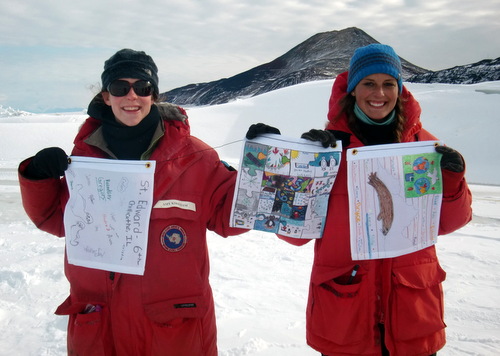
- Becky Shimp and her 6th grade students at St. Edwards School
- Mrs. Shadensack’s 6th grade students at Immaculate Conception School
- Bonney Haynes and her 4th – 6th grade students at Lamplighter Montessori School
There are 4 other amazing members of our team. Let’s meet them now!
Dr. Jennifer Burns – Our fearless leader
Our fearless leader, Dr. Jennifer Burns is our Principal Investigator (PI) on the project. She has been researching Weddell seals since she was a graduate student in the 1990s. During the 2012 Weddell seal study, Dr. Jenn noticed that a number of female seals were shedding their fur very late in the season. Weddell seals typically shed their fur in January and February. She also noticed that many of these ‘late shedders’ were female. So she asked a simple question, why? Since most of these seals were female, she wondered if there was a connection between when a seal sheds its fur and if and when she has a pup (baby seal).
This current project started because of that question and her curiosity. Pretty neat, huh!
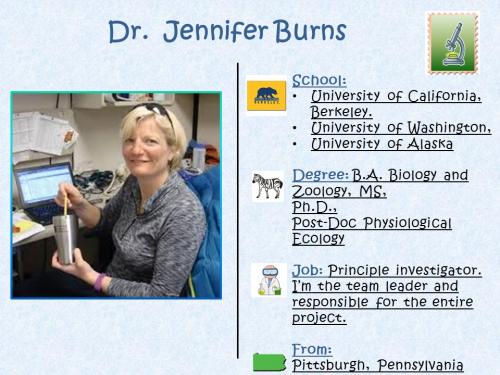
Team Tidbit from Dr. Jenn:
Dr. Jenn holds the ‘team record’ for the most number of times ‘on ice.’ She’s been down so many times that she’s lost count, but thinks it’s been 16 different times. WOW!
Dr. Rachel Berngartt – Veterinarian
Dr. Berngartt is the team veterinarian in charge of monitoring the seal, anesthetizing the seal and helping the scientists with all veterinary needs while the team is conducting their research. Anesthetizing the seals is necessary so that the scientists can get the samples they need while keeping the seals safely sleeping. Dr. Berngartt stays with the animal from the very start of the procedure all the way until the animal is fully awake again. She sits at the head of the seal so she can constantly monitor the seal's heart rate, respiratory rate (breathing) as well as other parameters to ensure that the seal is doing well. This is Dr. Berngartt's 5th year in Antarctica working on Weddell seals. She has also worked on many other types of marine mammals including Harbor seals, Fur seals, Steller sea lions, Elephant seals and California sea lions.
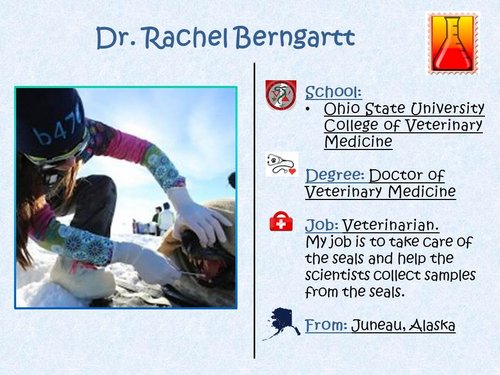
Team Tidbit from Dr. Berngartt:
I have a true passion for animals! I really love my Weddell seal buddies. I’ve always wanted to be a veterinarian ever since I was 3 years old.
Dr. Robert McCorkell
Meet Dr. McCorkell! His favorite part of the job is learning and discovering new information. Wow, we already have a lot in common! Like the other team members interested in pregnancy, his ‘tool of choice’ is the ultrasound. If a seal is pregnant, they can actually see the seal fetus (growing seal pup), while still inside the seal’s body. Like me, Dr. Rob is impressed with how competent the pups are when they are born. In a few short weeks after birth (about six weeks) they are on their own in the big wide ocean. Wow, these pups must learn quickly, six weeks is not a lot of time! He has worked with over 45 Weddell seals on this project but has said ‘hello’ to many more!
What he misses most while in Antarctica are sunsets. During the Antarctic summer, the sun never sets! It can be hard to tell time and figure out what direction you are going when the sun is always in the sky.
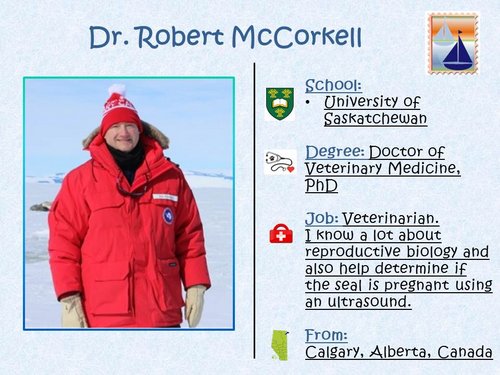
Team Tidbit from Dr. Rob:
If I had a free day in Antarctica, I would use it to hike around the McMurdo base and take pictures of the different sites and views. The area is strikingly beautiful and there are a few historic locations to visit and imagine what it would have been like to arrive here by sail boat more than 100 years ago.
Dr. Gregg Adams – Veterinarian
Dr. Adams is quite a character – fuller than life! As one of the veterinarians on the team, he is interested in the ‘reproductive status’ of our seals. In other words, he wants to know if our research subjects are going to have a pup (baby). Dr. Gregg helps the team collect this information by using an ultrasound – a device used to see the internal organs such as the heart, stomach, kidneys and ovaries. It is often used to detect pregnancy in humans and Weddell seals. You can tell from the picture below he was very excited to find out that one of our seals was indeed pregnant. This was the first Weddell seal pregnancy diagnosis EVER, so he had a reason to cheer!
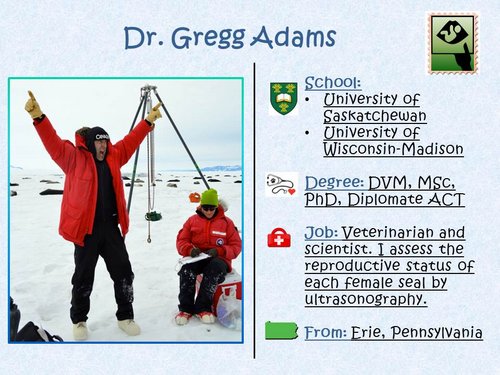
Team Tidbit from Dr. Adams:
Dr. Adams said, if he were a seal, he would haul out close to the helicopter so the seal team wouldn’t get ‘grumpy’ from having to carry our gear so far! I have to admit, that would be nice – we have a lot of gear and it’s heavy! Like me, he loves to fill his pockets with candy bars. It’s good to have a sweet treat when you are grumpy and trying to find seals!


Comments